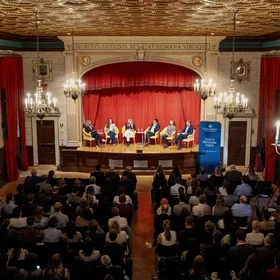By Matthew Sawyer, M.S. in Strategic Communication lecturer
During this summer’s M.S. in Strategic Communication Practicum, students in the program discovered firsthand the impact of generative AI in their field. Twelve students interned at various organizations, including a global data-analytics firm, a sports marketing agency, an international nonprofit, and a fashion e-commerce start-up. Nearly all these organizations had already been utilizing AI platforms, including ChatGPT, DALL-E, Copilot, and Gemini.
In their internships, students uncovered how these technologies are reshaping the practices, organizational structures, and competencies essential for strategic communication professionals. Their experiences, observations, and insights were shared in class discussions and assignments.
The Practicum Experience
The Practicum is a 12-week course that complements students’ internships, enhancing their professional performance and career development. Under the guidance of instructors Barbara McGloin and myself, students engage in reflective discussions and complete assignments, including writing blog articles about their on-the-job experiences and implementing concepts delivered in online lessons and readings.
Generative AI in Content Creation
Many students found AI valuable in generating content for articles, social media, and other communication materials. The technology helped them develop ideas, produce headlines, check grammar, and tailor messages for specific audiences. One student utilized AI to optimize a website’s search engine ranking by embedding keywords and suggesting hashtags, while another used it to translate advertisements into multiple languages.
Despite the technology’s impressive capabilities, students noted its limitations and dangers if overused. For example, AI-generated content often lacks the brand’s unique voice and personality. As one student put it, “AI doesn’t understand. It needs a personal touch.” The consensus was clear: Human intuition and creativity still outperform AI.
AI as a Brainstorming Partner
Students, particularly when working remotely and across different time zones, found AI to be helpful for ideation. One student used Copilot to generate name options for a new product. Another student developed gift ideas for an industry event by asking Claude.AI to summarize online articles and identify product trends. They then used DALL-E to create visual images of several gift ideas to present to an important retail executive.
While AI was able to produce numerous ideas instantly, students missed the collaborative and energizing aspects of traditional brainstorming sessions.

Image created by Khushie Ketan Zaveri using DALL-E
Image created by Khushie Ketan Zaveri using DALL-E
Streamlining Documentation
AI’s efficiency in handling administrative tasks like meeting notes and document summarization freed students to focus on higher-level projects. Otter.ai and other tools enabled them to participate in discussions while simultaneously producing meeting notes, an impossible feat without AI assistance. One student used AI to turn complex documents into simplified summaries with the prompt “Explain these [documents] to someone with no knowledge of technology.”
Enhancing Research Capabilities
Research is a critical component of both work and academics. AI tools enabled quick searches through vast data sets, published articles, and reports. One student used AI to screen celebrities for a PR campaign by identifying negative stories and reviews, which helped them avoid a problematic selection.
Students acknowledged the importance of verifying AI-generated work but were impressed by its ability to expedite tasks. “AI became an integral part of my daily workflow,” said one student. Another student, however, remarked that they never fully trusted AI’s findings and had to consistently take time to confirm its accuracy.
Reflections on the Overall Experience
Practicum students concluded that AI is already transforming communication and marketing functions in organizations of all sizes and industries. Most were excited about using the technology to produce more in less time and to minimize mundane tasks. They recognized, however, that as AI continues to evolve, it will demand professionals with advanced skills and industry knowledge to leverage these tools effectively.
The insights gained from the Practicum, both on the job and in the classroom, provided students with a competitive advantage as they embark on their careers. Through reflective writing and discussions, students learned from one another’s experiences, gaining diverse perspectives and insights that enhanced their understanding of AI’s role in the workplace. In our collaborative learning environment, students are encouraged to embrace technology and develop new skills to be leaders in the ever-changing field of strategic communication.

Image created by Matthew Sawyer using DALL-E
Image created by Matthew Sawyer using DALL-E
About the Program
The business world’s around-the-clock communications challenges are demanding a new level of strategic thinking. Columbia University’s Master of Science in Strategic Communication graduates emerge equipped with all the essential skills and tools for a successful career in a wide range of communication fields.



